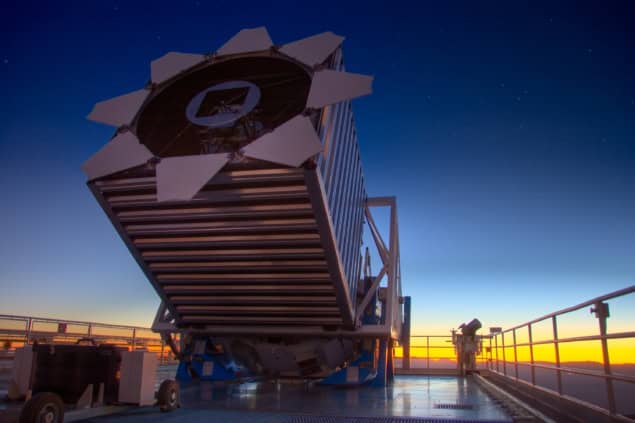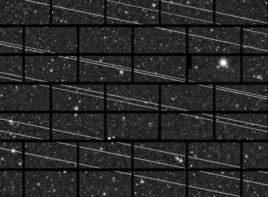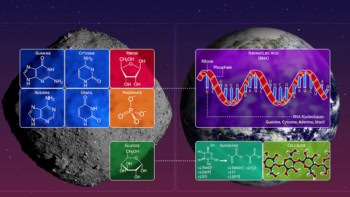The Sloan Digital Sky Survey has been working since the start of the millennium to create a “map” of the universe. During that time, hundreds of astronomers have built their careers on its data. Here, two of them, Xiaohui Fan and David Law, reflect on how the collaboration shaped their development as researchers

Physics World: How did you get involved in the Sloan Digital Sky Survey (SDSS)?
Xiaohui Fan: In 1994 I was studying for my Master’s degree in China, working on a smaller imaging survey project and developing my method of looking for distant quasars. I came across the SDSS in the literature when the survey was still in the development stage, and I immediately knew what I wanted to do for my PhD. So I applied to Princeton University, basically saying that I wanted to work on the SDSS because it would revolutionize survey astronomy and I thought I had both the interests and the skills needed. I got in and was welcomed to the project with open arms. I spent the next five years working in the SDSS group at Princeton, and in the end, I carried out the observations and analysis that resulted in the discovery of the first sample of distant quasars – including one that broke the record at the time for the most distant quasar. I never thought that I should or could be the lead author of the first paper based on SDSS survey data, because I was a graduate student at the time, and because the survey is so much more this initial discovery – it involved years of work by many people. So I was surprised and humbled by the fact that I was told to lead the paper (Fan et al. 1999 ApJ 117 2528). It was a tremendous responsibility, which I think always brings the best out of your ability.
David Law: A few years ago, when I was a Hubble Fellow, a colleague of mine from graduate school, Kevin Bundy, had an idea for a new integral-field unit (IFU) spectroscopic survey of nearby galaxies. He knew that I had some experience using such systems in the past, and although he was not part of the SDSS, he had been discussing his ideas with Jim Gunn, one of the survey’s founders. Initially, Kevin asked if I could adapt my simulation code to estimate the typical data quality that we could expect in our proposal, but what started as some quick simulations to explore the capabilities of such a new instrument gradually evolved over the next few years into leadership of the software and analysis team of what became the MaNGA (Mapping Nearby Galaxies at APO) project.
PW: What is MaNGA about?
DL: The overall goal of the project is to take the statistical power of the SDSS and use it to explore the internal properties of galaxies – a largely uncharted regime. In previous generations of the SDSS, all of the millions of galaxies that had been observed with spectroscopy used just a single fibre per galaxy – treating the galaxy as a point object. Galaxies aren’t points, though. They have rich and varied structures, with internal motions, chemical evolution and feedback from one generation of star formation influencing the next. In order to study this kind of structure we need spectroscopy. Spectra are what tell us the physics of astronomical objects, what they’re made of, how they’re moving, where they came from and so on. While a few tens to a few hundreds of the brightest, most accessible galaxies had been studied in such a way, the purpose of MaNGA is to observe a representative sample of 10 000 galaxies across a wide range of masses, star formation rates, morphologies and environments. The goal is to understand the “life history” of current-day galaxies.
PW: What have you learned from working as part of the SDSS?
XF: One thing I learned is the paramount importance of the free exchange of ideas and open use of data. SDSS data are available for all collaboration members to explore. There is no restriction on working on any projects one wishes to, provided one follows SDSS rules of announcing the projects so that others can collaborate with you. The SDSS has made many unexpected discoveries, partly because it is so powerful as a survey tool, but also because it encourages open minds and open eyes to look for things beyond our own immediate narrow interests. For example, after the quasar discovery, I was a key member of the team that discovered new classes of brown dwarfs (basically failed stars or free-floating planets) using SDSS data. This is an area that I knew nothing about: we found them simply because they were “contaminants” in our quasar selection process. But there were no pre-defined areas of research, and we were encouraged to work closely with experts on stars.
Another lesson from the SDSS is the importance of encouraging, promoting and really challenging young scientists to take leadership roles, while at the same time providing guidance and protections for them on the policy side. The freedom and the responsibility I had on my first paper experience were really key to my growth. I think many of my peers, who “grew up” in the SDSS as students and postdocs, felt the same way. The SDSS benefited greatly from innovative contributions by a generation of young astronomers who were familiar with the digital age, with big data and with collaborative research, and to make the best use of all that expertise and creativity, it was equally important for the SDSS leadership to promote and protect the interests of junior scientists. We were all extremely grateful for the unselfish service (and, in many cases, sacrifice) of our mentors and leaders, which I think allowed the best science to come out of the project.
DL: At first, what I learned mostly broadened my technical expertise. For example, working with SDSS engineers gave me an appreciation for the interface between software design and the realities of physical hardware, while learning from more senior members of the SDSS collaboration dramatically improved my knowledge of practical large-scale collaborative software development. Later on, as the project reached maturity, it was my scientific expertise that began to expand by bringing my technical knowledge to bear on the variety of science topics being pursued by the rest of the large MaNGA science team.
PW: How did this experience help your career?
XF: After more than 20 years, and now as a senior faculty member, I am still working on SDSS data. It has been the one constant of my career, even as I have expanded my research. My role evolved from hands-on analysis of data, to organizing a team to explore new ways of using the data, and more recently to representing my institution on the SDSS advisory board – setting policies, evaluating progress and planning new directions. The two most important things I learned from SDSS – to prepare for the unexpected discoveries, and to encourage the next generation astronomers – are also the principles of how I conduct my research and lead my own research group and projects. One of my most satisfying experiences as a faculty member happened when one of my students analysed SDSS data in a different way, and this new analysis resulted in the discovery of a remarkable new quasar that was missed by the original SDSS selection method that I developed as a student. This object turned out to be the most luminous quasar in the early universe, powered by a 12 billion solar mass black hole at its centre (Wu et al. 2015 Nature 518 512) – a surprise discovery that is challenging the theory of black hole formation in the early universe.
DL: After a graduate school experience working with a very small and close research group, the opportunity to work with so many SDSS scientists from around the world has been an incredible way of broadening my contacts within the astronomical community. Many of us who started the MaNGA project did so as postdocs, and we have continually been impressed with the leadership roles and responsibilities that were open to us within the project. As the MaNGA data group lead and part of the executive committee, even as a postdoctoral fellow myself I had the opportunity to hire and supervise the team of postdocs tasked with various aspects of the project software development.
All of this experience leading a team to design, build, and operate an IFU software and analysis pipeline while interacting regularly with scientists, engineers and technical staff was invaluable when it came time to apply for permanent positions. Now, as a tenure-track assistant astronomer at the Space Telescope Science Institute, I can look back and see that my experience with the SDSS was nearly ideal preparation.



